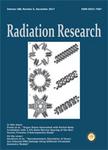版权所有:内蒙古大学图书馆 技术提供:维普资讯• 智图
内蒙古自治区呼和浩特市赛罕区大学西街235号 邮编: 010021

作者机构:[a]Applied Molecular Oncology and Radiation Medicine Program Ontario Cancer Institute/Princess Margaret Hospital (UHN) Toronto Ontario Canada [b]Department of Biostatistics and Computational Biology University of Rochester Medical Center Rochester New York [c]Departments of Medical Biophysics and Radiation Oncology University of Toronto Toronto Ontario Canada Bhogal N. Kaspler P. Jalali F. Hyrien O. Chen R. Hill R. P. and Bristow R. G. Late Residual γ-H2AX Foci In Murine Skin are Dose Responsive and Predict Radiosensitivity In Vivo.
出 版 物:《RADIATION RESEARCH》 (辐射研究)
年 卷 期:2010年第173卷第3期
页 面:399-400页
核心收录:
学科分类:0710[理学-生物学] 070207[理学-光学] 07[理学] 08[工学] 0803[工学-光学工程] 1009[医学-特种医学] 0702[理学-物理学]
基 金:National Institute of Allergy and Infectious Diseases NIAID (U19AI067733)
主 题:Skin Dose response relationship Irradiation Epidermal cells Radiotherapy DNA repair Radiation dose response relationship Mice Biopsies
摘 要:Accurate biodosimetry is needed to estimate radiation doses received in vivo from accidental or unwarranted radiation exposures. We investigated the use of DNA repair foci (e.g. γ-H2AX) at late times after irradiation in vivo as a biodosimeter of initial ionizing radiation dose. Two radiosensitive strains (SCID and BALB/c) and two radioresistant strains (C57BL/6 and C3H/HeJ) were used to quantify γ-H2AX foci in a skin tissue microarray after doses of 1 to 10 Gy at early and late times after irradiation (1 and 7 days). Using a 3D quantitative immunofluorescence microscopy analysis, we observed a dose response for γ-H2AX foci for all strains at 30 min, 24 h and 7 days after irradiation. The numbers of residual foci were significantly different between each of the four strains and reflected the relative radiosensitivity in vivo. In comparing γ-H2AX focus and micronucleus formation after irradiation, we also observed association between the number of micronuclei and number of foci after 1 and 7 days between radiosensitive and radioresistant strains. We conclude that 3D image analysis of γ-H2AX in skin can be used to detect relative radiosensitivity based on late residual γ-H2AX foci. This technique may be a useful biodosimeter to determine dose at times up to 1 week after accidental or catastrophic radiation exposure in vivo.